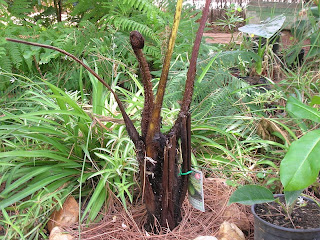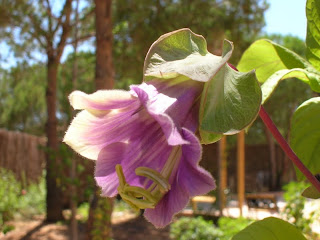IPOMOEA PURPUREA "Carnevale di Venezia"
Origen: México y Centroamérica aunque naturalizada en muchas regiones tropicales y subtropicales del mundo.
Es una trepadora anual o vivaz de corta vida.
Hay muchos cultivares. El que hoy presento creo que se llama "carnevale di Venezia" y es también conocido por "Aomurasakizyouhantenshibori". El primero de los nombres procede del hecho de que esta variedad fue comercializada en Venecia desde antiguo (desde los tiempos de las cruzadas) aunque su origen exacto era incierto. El segundo nombre significa algo así como "azul purpureo rayado manchado y moteado" lo que viene a describir el aspecto de las flores.
Se reproduce y autoreproduce muy bien por semillas por lo que, aunque normalmente se comporta como anual, nuevas plantas vienen a sustituir a la que murió el invierno pasado.
Por cierto, las semillas han sido utilizadas como droga psicodélica, pues contienen una droga conocida como LSA que provoca efectos casi idénticos a los del LSD.
Esta planta creció en Recregarden de forma espontánea. Muchas veces semillas plantadas con todo el cariño y todos los cuidados no germinan y una semilla venida de no se sabe dónde germina sola. Este es el caso.
English version:
Origin: Central America although naturalized worldwide in tropical and subtropical areas
Common name: Purple, Tall or Common Glory Morning
It´s an annual or short lived perennial climber.
There are many cultivars. One of them is "Carnevale di Venezia", also known as "Aomurasakizyouhantenshibori". First name is due to the fact that this cultivar has an historical connection with Venice. Apparently this plant has been grown in Venice since historical times, at least since the Crusades but where it came from before is uncertain.
Second name means some like this: Bluish-purple, Striped, Spotted and Dapple. That´s how the flowers look like.
Propagation is easy by seed. In fact it selfseeds very easily so although the plant usually behaves as annual, new plants grow where the mother died.
Seeds are reported to contain LSA, a psychedelic drug with similar effects to LSD.
This plant grew spontaneusly in Recregarden. Nobody sowed it. Sometimes seeds sowed with all cares don´t germinate and a seed come from nowhere does. That´s an example.






























